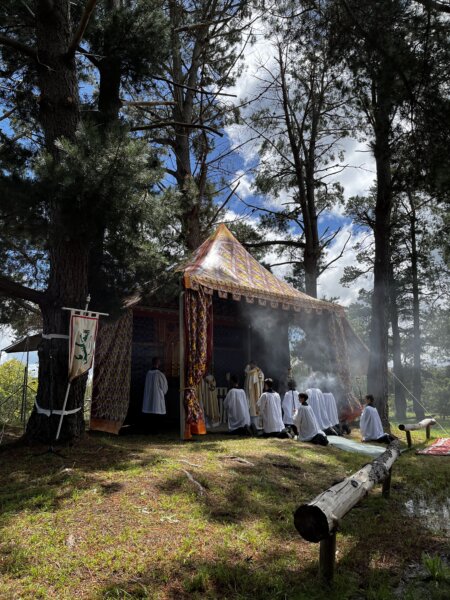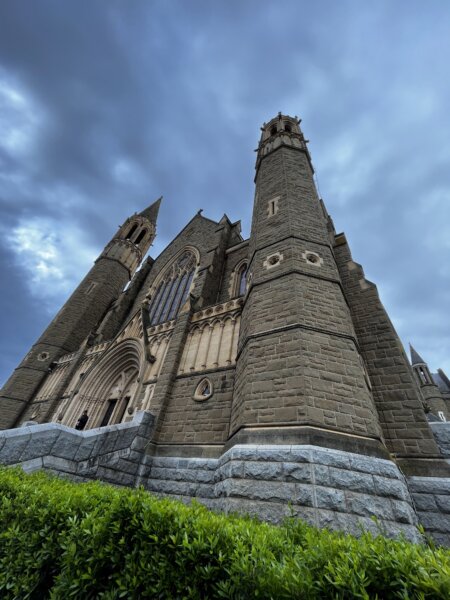Many pilgrimages take place on Pentecost or during Whitsun Week.
From One Peter Five
By Dickson Leong
How beautiful are thy tabernacles, O Lord of hosts! My soul longeth and fainteth for the courts of the Lord (Psalm 83:1).
These beautiful words were prayed by the Israelites as they made their annual pilgrimage to the Temple of Jerusalem for the feast of the Passover. The concept of a pilgrimage is one that has deep roots in Christian tradition, since it has ties all the way from the Biblical era. From the journey of Abraham, to the exodus of the Jews as they prepared to enter the promised land, to the journey of Christ towards Jerusalem to face His Passion, all of these events in salvation history have the spirit of pilgrimage ingrained in them. This spirit of pilgrimage is a microcosm of earthly life itself, since our true home is to attain unto the beatific vision in heaven, and we thus recognize that all earthly joys are only fleeting. Just as Christ knew that His principal mission was to suffer His Passion in Jerusalem, so we too should realize that our principal end is to attain unto eternal life by faith and a holy life.
Although all pilgrimages are only tiny steps along the great pilgrimage of earthly life, the Church has always recognized their spiritual value, and thus special indulgences were attached to many of the popular pilgrimage sites. The most prized of all pilgrimages was the pilgrimage to the Holy Land, since the Holy Land was sanctified by the life of Our Lord Himself, and it is in the Holy Land that we are able to come into contact with the very same sites where the mysteries of salvation unfolded. However, since the journey to the Holy Land has historically been one of the most dangerous journeys on account of the long distance, the presence of bandits, and the hostility of the surrounding nations (e.g. the Ottomans), many Christians in Europe would find it more feasible to make pilgrimages within Europe itself. Thus, the city of Rome naturally became the next most popular pilgrimage site, since Rome is the seat of Christendom and holds the tombs of the Holy Apostles, Peter & Paul.
Additionally, the tomb of St. James the Greater in Compostela in Spain also attracted many pilgrims, and up to this day, devout Christians would still travel on foot to the Basilica of Santiago de Compostela to visit the tomb of this great apostle.
Today, there is an abundance of pilgrimage sites and modern transport has made these sites more accessible and affordable than ever before in history. In fact, it almost seems like most pilgrimages today have taken on the character of a ‘holy vacation’ that wealthier Catholics can enjoy. While there is nothing inherently wrong with this, perhaps most people are unaware that for most of history, pilgrimages generally carried a penitential spirit, on account of the ardor of the journey which had to be carried out on foot or horseback before the invention of modern transportation. Thus, pilgrimages were bittersweet events, where the thrill of adventure was mixed with the challenges that naturally entailed long journeys. This fits in perfectly into the experience of earthly life, which carries a mixture of joys as well as sorrows. It is no wonder that the Church has always looked favorably upon this holy practice.
Last fall, I attended the 30th Christus Rex Pilgrimage in Australia, which took place from 28th to 30th October. This pilgrimage was started in 1991 and pilgrims journey roughly 90km by foot from St. Patrick’s Cathedral in the town of Ballarat to the Sacred Heart Cathedral in the town of Bendigo. This pilgrimage is mostly attended by Catholics who have a special love for the traditions of the Church and the pilgrimage is undertaken in honor of the Kingship of Christ, culminating with the traditional feast of Christ the King on the last Sunday of October.

All photos by the author

The Traditional Mass is celebrated each day of the pilgrimage, and pilgrims can avail themselves to confessions and sermons by priests who accompany the pilgrimage as chaplains.

The event was physically and mentally strenuous, but it was a great opportunity to bear witness to our faith and to give glory to Christ the King. Pilgrims offer their prayers and penances that Christ may reign once more in our societies. This year’s pilgrimage attracted over 600 pilgrims, mostly first-timers from across Australia, and the closing Solemn Mass at the Bendigo Cathedral was deeply moving to many pilgrims.


The Christus Rex Pilgrimage is however, only one instance of a modern-day walking pilgrimage, and it would be helpful if more Catholics knew about such events that take place around the world. Here are some other instances of walking pilgrimages where the traditional liturgy is used:
The Chartres Pilgrimage
Pilgrims cover a distance of 100km over 3 days, and the nights are spent camping at designated campsites. This is the biggest gathering of traditionally-minded Catholics in the world and the closing Mass at the Chartres Cathedral is sometimes celebrated by high-ranking prelates such as Cardinals Burke, Sarah, and Hoyos. Most other pilgrimages around the world hosted by traditionally-minded Catholics draw their inspiration from the Chartres pilgrimage, so if you would like to make your first pilgrimage and you find yourself uncertain which one to select, the Chartres pilgrimage should ideally be your first choice.
More details about the Chartres pilgrimage can be found here
Walsingham Pilgrimage
More information on the Walsingham Pilgrimage can be found here
Covadonga Pilgrimage
More information on the Covadonga Pilgrimage can be found here
Lujan Pilgrimage
More information on the Lujan Pilgrimage can be found here
***
Pilgrimages are great opportunities to bear a public witness to the vitality of our faith, and above all, they bear great spiritual profit to those who participate in the right spirit. It is an incredibly rejuvenating experience to step out of the comfort of our parishes to take part in such pilgrimages, which connects us to the faith of Christians of ages past. The penitential aspect of these pilgrimages is not something to be spurned upon, since Our Lord told His disciples that certain demons are only driven out by prayer and fasting (Matthew 17:21). If travelling to an international pilgrimage is not feasible, one may try to find one that is closer to home, or perhaps even look into organizing a pilgrimage in your locality. There are also shorter pilgrimages that can be completed in one day, and these can be great options to those who are unable to commit to 3 days of walking.
Amidst the great perils which threatens us from both within and outside the Church, we need to have recourse to prayer and penance more than ever. Although different pilgrimages are bound to have slightly different aspects, they all aim towards the rebuilding of Christendom. May we learn to offer ourselves generously to voluntarily suffer as victims of our era so that modern society may once more return to God.
No comments:
Post a Comment
Comments are subject to deletion if they are not germane. I have no problem with a bit of colourful language, but blasphemy or depraved profanity will not be allowed. Attacks on the Catholic Faith will not be tolerated. Comments will be deleted that are republican (Yanks! Note the lower case 'r'!), attacks on the legitimacy of Pope Leo XIV as the Vicar of Christ, the legitimacy of the House of Windsor or of the claims of the Elder Line of the House of France, or attacks on the legitimacy of any of the currently ruling Houses of Europe.